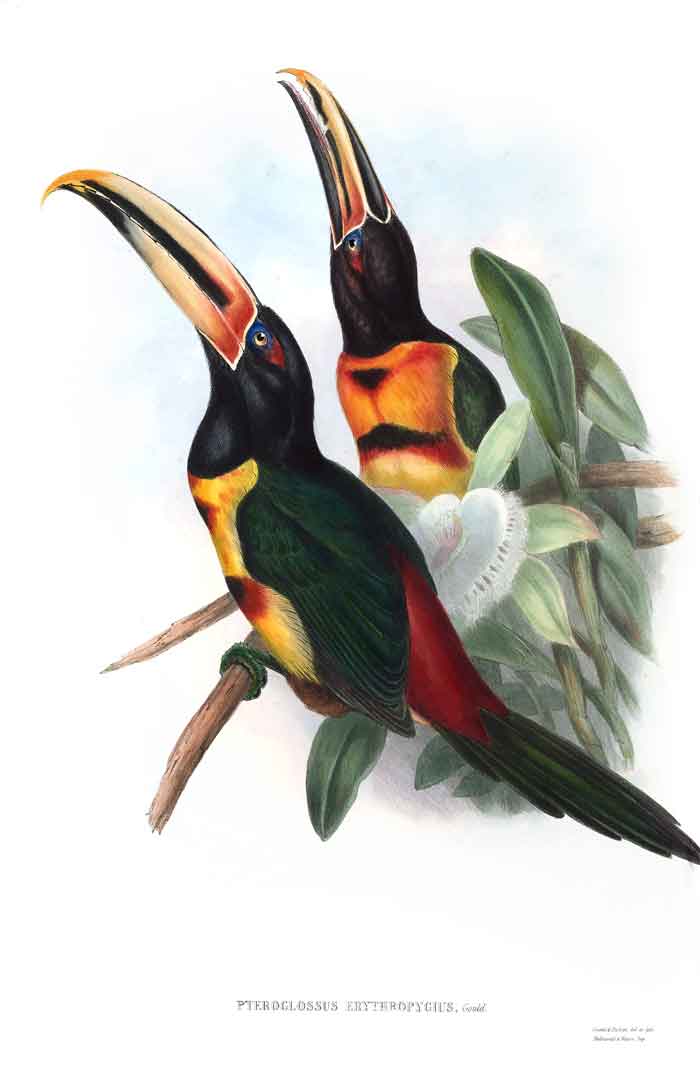
Pteroglossus erythropygius (*)
Superregnum: Eukaryota
Cladus: Unikonta
Cladus: Opisthokonta
Cladus: Holozoa
Regnum: Animalia
Subregnum: Eumetazoa
Cladus: Bilateria
Cladus: Nephrozoa
Superphylum: Deuterostomia
Phylum: Chordata
Subphylum: Vertebrata
Infraphylum: Gnathostomata
Megaclassis: Osteichthyes
Cladus: Sarcopterygii
Cladus: Rhipidistia
Cladus: Tetrapodomorpha
Cladus: Eotetrapodiformes
Cladus: Elpistostegalia
Superclassis: Tetrapoda
Cladus: Reptiliomorpha
Cladus: Amniota
Classis: Reptilia
Cladus: Eureptilia
Cladus: Romeriida
Subclassis: Diapsida
Cladus: Sauria
Infraclassis: Archosauromorpha
Cladus: Crurotarsi
Divisio: Archosauria
Cladus: Avemetatarsalia
Cladus: Ornithodira
Subtaxon: Dinosauromorpha
Cladus: Dinosauriformes
Cladus: Dracohors
Cladus: Dinosauria
Ordo: Saurischia
Cladus: Eusaurischia
Subordo: Theropoda
Cladus: Neotheropoda
Cladus: Averostra
Cladus: Tetanurae
Cladus: Avetheropoda
Cladus: Coelurosauria
Cladus: Tyrannoraptora
Cladus: Maniraptoromorpha
Cladus: Maniraptoriformes
Cladus: Maniraptora
Cladus: Pennaraptora
Cladus: Paraves
Cladus: Eumaniraptora
Cladus: Avialae
Infraclassis: Aves
Cladus: Avebrevicauda
Cladus: Pygostylia
Cladus: Ornithothoraces
Cladus: Ornithuromorpha
Cladus: Carinatae
Parvclassis: Neornithes
Cohors: Neognathae
Cladus: Neoaves
Ordo: Piciformes
Familia: Ramphastidae
Genus: Pteroglossus
Species: Pteroglossus erythropygius
Name
Pteroglossus erythropygius Gould, 1843
References
Proceedings of the Zoological Society of London Pt. 11 no. 121 p. 15
Vernacular names
English: Pale-mandibled Aracari
magyar: Vörösfarkú arasszári

The pale-mandibled aracari or pale-billed araçari (Pteroglossus erythropygius) is a near-passerine bird in the toucan family Ramphastidae.[2] It is found in Ecuador and Peru.[3]
Taxonomy and systematics
The International Ornithological Committee (IOC) and BirdLife International's Handbook of the Birds of the World (HBW) recognize the pale-mandibled (pale-billed) aracari as a species.[2][4] However, the South American Classification Committee of the American Ornithological Society and the Clements taxonomy treat it as a subspecies of the collared aracari (P. torquatus).[5][3]
The pale-mandibled aracari is monotypic.[2]
Description
The pale-mandibled aracari is 40.5 to 43 cm (16 to 17 in) long including its 11.5 to 12.5 cm (4.5 to 4.9 in) bill. It weighs 175 to 250 g (6.2 to 8.8 oz). Males and females have the same coloration of the bill and plumage but the female's bill is shorter than the male's. The adult's bill has a narrow vertical white line at its base. Its maxilla is creamy yellow with a black stripe along its lower edge. The bill's mandible is creamy yellow with a black tip. Adults have mostly glossy black upperparts with bright red lower back, rump, and uppertail coverts. Their head, throat, and uppermost breast are greenish black. Their lower breast, belly, and undertail coverts are yellow. The breast has a variable red wash and a black spot in its center; the upper belly is crossed by a narrow red and black band. Their thighs are brown. Juveniles are much duller than adults, with a sooty-black head and chest and brownish olive upperparts. The red rump and yellow underparts are paler, and the breast spot, belly band, and bill pattern are indistinct.[6][7]
Distribution and habitat
The pale-mandibled aracari is found from northwestern Ecuador's Esmeraldas Province south into Peru's Department of Tumbes.[3][7] It inhabits the interior and edges of evergreen primary forest and mature secondary forest and also coffee, cacao, and fruit plantations.[7]
Behavior
Social behavior
Pale-mandibled aracaris typically travel in groups of about six to eight or more individuals that sometimes include other toucan species. They also roost communally; up to seven may occupy a cavity overnight.[7][6]
Feeding
The pale-mandibled aracari's diet is mostly fruit but it also feeds on large insects, the eggs and nestlings of other birds, and other small vertebrates. It mostly forages from the forest's mid level to the canopy but will feed on fruits in the understory. They glean fruit by stretching from a perch, bending, and even hanging upside down. They regurgitate large fruit seeds which often remain viable.[7]
Breeding
The pale-mandibled aracari's breeding season is from December to May. It nests in tree cavities, usually those excavated by large woodpeckers but also natural ones. They may enlarge the cavity, which can be up to 30 m (98 ft) above the ground. The clutch size is usually three eggs but can be as large as five. The incubation period is 16 to 17 days and both parents incubate. Fledging occurs 26 to 30 days after hatch. The parents and often up to three other adults provision the nestlings. They are fed mostly with insects when young.[7]
Dickcissel male perched on a metal pole singing, with neck stretched and beak open.
Songs and calls
Listen to pale-mandibled aracari on xeno-canto
Vocalization
The pale-mandibled aracari's usual call is "a loud, arresting, high-pitched, and squeaky 'ksisik' or 'ksiyik!'."[6]
Status
The IUCN has assessed the pale-mandibled aracari as being of Least Concern, though its population size is not known and is believed to be decreasing. No immediate threats have been identified.[1] "[A]lthough it tolerates secondary forest, it nonetheless is very susceptible to deforestation".[7]
References
BirdLife International (2016). "Pale-billed Araçari Pteroglossus erythropygius". IUCN Red List of Threatened Species. 2016: e.T22724652A94874977. doi:10.2305/IUCN.UK.2016-3.RLTS.T22724652A94874977.en. Retrieved 23 December 2022.
Gill, F.; Donsker, D.; Rasmussen, P., eds. (August 2022). "Jacamars, puffbirds, barbets, toucans, honeyguides". IOC World Bird List. v 12.2. Retrieved December 15, 2022.
Clements, J. F., T. S. Schulenberg, M. J. Iliff, T. A. Fredericks, J. A. Gerbracht, D. Lepage, S. M. Billerman, B. L. Sullivan, and C. L. Wood. 2022. The eBird/Clements checklist of birds of the world: v2022. Downloaded from https://www.birds.cornell.edu/clementschecklist/download/ retrieved November 10, 2022
HBW and BirdLife International (2022) Handbook of the Birds of the World and BirdLife International digital checklist of the birds of the world. Version 7. Available at: http://datazone.birdlife.org/userfiles/file/Species/Taxonomy/HBW-BirdLife_Checklist_v7_Dec22.zip retrieved December 13, 2022
Remsen, J. V., Jr., J. I. Areta, E. Bonaccorso, S. Claramunt, A. Jaramillo, D. F. Lane, J. F. Pacheco, M. B. Robbins, F. G. Stiles, and K. J. Zimmer. Version 24 July 2022. A classification of the bird species of South America. American Ornithological Society. https://www.museum.lsu.edu/~Remsen/SACCBaseline.htm retrieved July 24, 2022
Ridgely, Robert S.; Greenfield, Paul J. (2001). The Birds of Ecuador: Field Guide. Vol. II. Ithaca: Cornell University Press. p. 325. ISBN 978-0-8014-8721-7.
Green, C. and R. Kannan (2020). Collared Aracari (Pteroglossus torquatus), version 1.0. In Birds of the World (T. S. Schulenberg, Editor). Cornell Lab of Ornithology, Ithaca, NY, USA. https://doi.org/10.2173/bow.colara1.01 retrieved December 23, 2022
Retrieved from "http://en.wikipedia.org/"
All text is available under the terms of the GNU Free Documentation License

